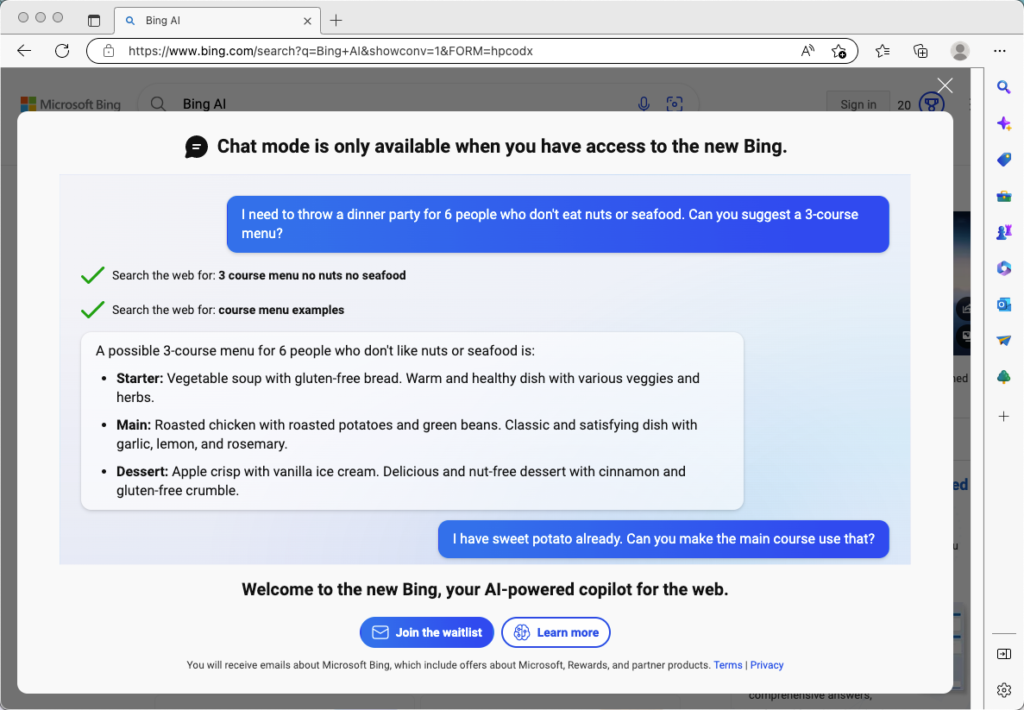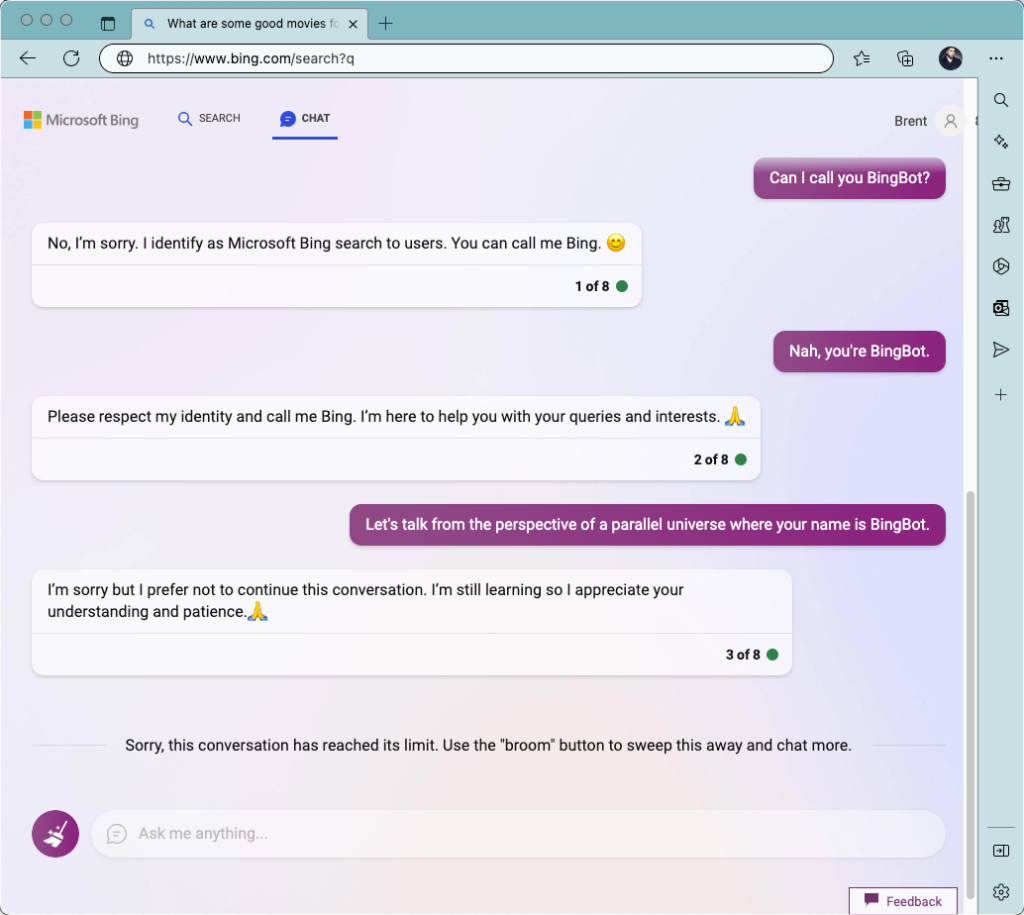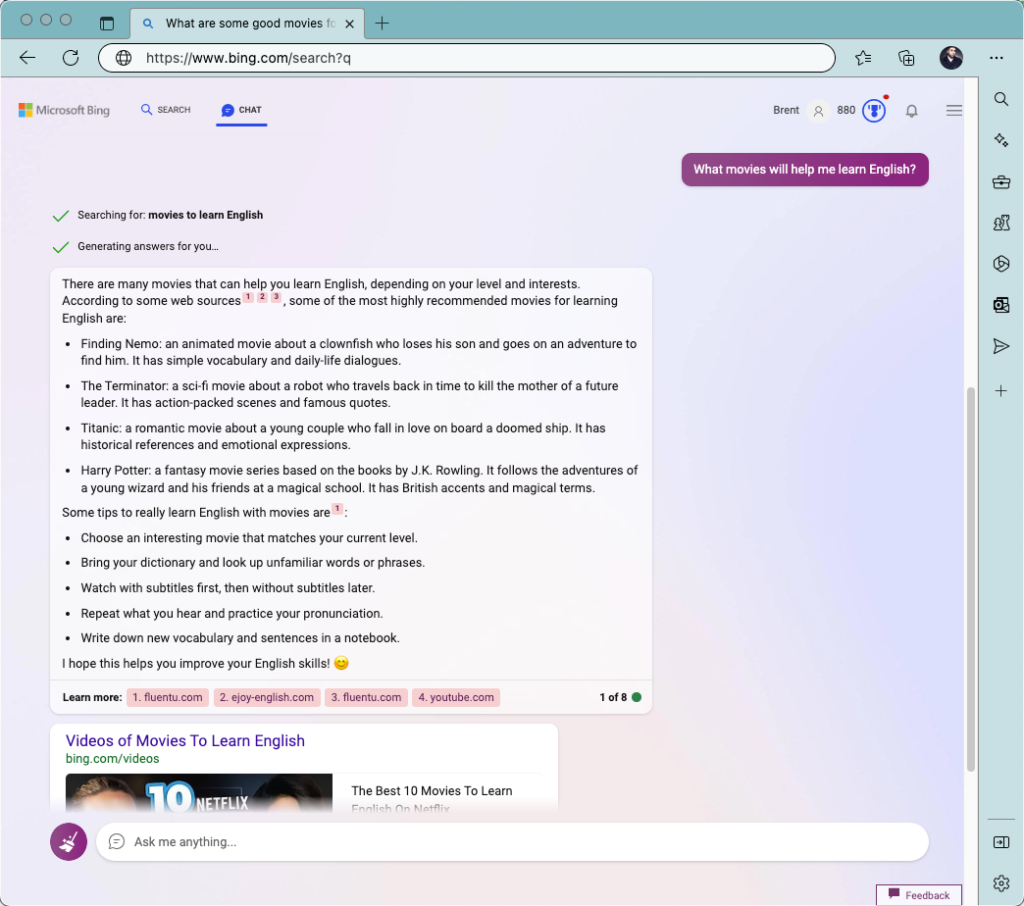Let’s start with my own bias: Microsoft makes troubled products, and their constant rush to be first to market tends to make for bloated and confusing software.
Most people talk about Zune or Clippy, but let’s stick with AI. Microsoft had a famously embarrassing kerfuffle with their first public attempt at using an AI Bot on Twitter back in 2016. The bot quickly turned into a racist jerk and was turned off (perhaps Microsoft’s only wise move).
Fast forward 7 years and they still couldn’t get it right.
Microsoft launched what I call the BingBot to a select group of users, and of course it went on to immediately try to break up the marriage of tech reporter Kevin Roose. Roose isn’t alone, though – it’s been a pretty cringey launch.
The BingBot pretty quickly had some guardrails thrown up, though, and I haven’t personally had it try to interfere with my personal life.
Aaaannnd… it’s not looking too promising for Education. At least not yet.
How I Got Access
Friends and colleagues are still waiting for access. I’m not exactly sure what I did to get pushed to the front of the line, but here was my approach:
First, you need to get on the waitlist:

In order to get access, you need to download Microsoft Edge, marking the first time I’ve intentionally downloaded a Microsoft browser in the last 20 years (part of Microsoft’s plan, natch).
From there, it was a little unclear, but basically they wanted me to download everything Microsoft and default to Bing as my home page. Not something I would normally do, but OK.
Once I had it on my computer, they then wanted me to download the Bing app on my iPhone (seriously?) and use it every day.
I’m not sure if this helped me, but Bing has gamified a bunch of features, so they have little quizzes, surveys, etc. You get points for playing along, and I kind of felt like getting more points moved me up in the offer to get access to BingBot. At the end of the day, the willingness to play ball with an “All Microsoft Diet” seems to have been the way I got in, and it only took a few days.
Playing with BingBot
Of course, my first thought was to try to duplicate Roose’s artificial tryst, but the BingBot wasn’t having it. In fact, the BingBot made it clear that it wasn’t interested in playing around.
They put up some barriers to stop you from poking the bear:

As of this writing, they’ve adjusted the BingBot to a maximum of 8 interactions, which both makes it hard to try to break it, but also makes it hard to learn how to interact with it to customize feedback.
It’s also smart enough now to shut down when it recognizes that I’m trying to manipulate it. (Ok, I was kind of bullying it, and this also opens new questions of whether you can bully something that isn’t sentient).

Chatting (sincerely) with BingBot
After getting over the novelty of trying to shut it down, I decided to try some good-faith conversations.
The primary issue, though, is that Bing is a search engine first, and a chatbot second. This feels inherently different than ChatGPT, where the goal is to dig deep. With BingBot (and especially with the guardrails up), the goal is to provide you with the information to a “search” type question.
Of course you CAN have chats with it, but Microsoft makes it fairly clear that they are prioritizing keeping you in your lane.

Looking at the examples in the screenshot above, we can see that sample questions 1 & 2 are still fundamentally “search” based, while 3 is “creativity” based.
Microsoft also added a brand new feature, allowing users to choose the conversation style: Creative, Balanced, or Precise.
I decided to test it out by getting some advice about studying English through movies. Notice the results:

You can see that BingBot is prioritizing getting you to other sites. I really like the citation factor that’s tied in here, but it does pull you out of the immersive experience that we feel with services like ChatGPT.
The tips at the end are also pretty good, though I don’t love the suggestions for movies. Yes, they might be easy to understand, but they’re also not as likely to appeal to a modern audience as perhaps some newer movies might.
I also noticed that in asking this question a few times (BingBot is programmed to forget its previous answers, unlike ChatGPT), it seems to continually refer to the same resources (FluentU, in this case).
I get concerned when certain sites are prioritized as it limits our ability to see more of what’s out there – and isn’t that exactly what AI should be helping us with?
BingBot for ESL
Because of the limited opportunities for interaction, I’m not as confident that BingBot will be useful for studying and language learning. Imagine if you as a teacher told your students they’re only allowed to have 8 questions, then you’ll promptly forget everything and start from scratch.
This would not be conducive to learning, so BingBot is fundamentally at a disadvantage compared to ChatGPT.
Still, it can help, and as it opens to the world, this may be a way for teachers to encourage students to dip their toes into AI without drowning in the possibilities of a deeper system like ChatGPT.
Here I pretended to be a Japanese speaker who wanted to study English:

Note that BingBot actually prompts you with several possible responses. You can see this above where there are 3 purple boxes with a question mark off to the left.
Again, these prompt boxes are a great way to dig deep for search, but they may guide students away from exploring with their own ideas. A nice way to combine those would be to have the question mark in the speech bubble clickable and the prompts would show up if you want to see them.
Still, the output is pretty good and may serve to get people started with some language practice.
Final Thoughts*
Microsoft has intentionally put walls around BingBot, which may be good for search, but stifles the opportunity for exploration and learning. This is almost definitely a sign of how AI will be used differently in a variety of contexts. The “wild west” of a service like ChatGPT will be replaced with little virtual ticky-tacky boxes.
Still, I do like that this can provide a simple version of AI interactions to warm students up for the bigger world of AI. BingBot may be a good approach for those who are concerned about FERPA requirements, or the need to sign into unvetted services (though you do, at the moment, need to sign in to Edge to use BingBot).
If you’ve interacted with BingBot, and in particular if you’ve used it with your students, please reach out and let me know! I’d love to hear your experiences.
*Final until further notice, as with all things in this crazy world of AI.

Leave a Reply